Most of us have had the experience of moving from one place to another, deciding what to take and what to discard, packing everything, transporting it, unpacking, and rearranging our belongings in a new setting. In the summer of 1781, the residents of the Southeast Rowhouse at Michilimackinac had that same experience as the garrison and community relocated to Mackinac Island.
Over the past ten summers archaeologists have been excavating a cellar in the southeast corner of House E of the Southeast Rowhouse as part of the ongoing excavation of the house. It appears that the cellar was filled with objects discarded during the move. These artifacts, especially the ceramics, give us glimpses into daily life in the household.
We do not know who lived in the house in 1781. The last documented occupant was an “English trader” noted on a 1765 map drawn by Lt. Perkins Magra. Preliminary analysis of material excavated thus far indicates the house was occupied by a wealthy English merchant and his household throughout the British era at the fort.
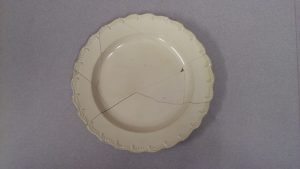

One line of evidence used to reach this conclusion is the quality and variety of ceramics found in the house, cellar and yard. The most common ceramic type found in the house is creamware. Creamware was developed in the early 1760s by Josiah Wedgwood when he succeeded in creating earthenware vessels as thin as Chinese porcelain. This plate (left) is the most complete creamware vessel found in the house. The way the sherds were piled when they were found indicates the plate was broken elsewhere and thrown into the cellar.
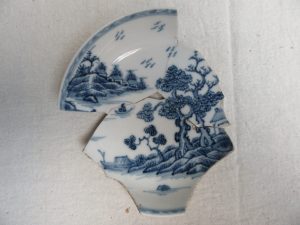

We have also found a nearly intact Chinese export porcelain saucer in the cellar (right). This would have been used for serving tea, an important social ritual for 18th century British people. Expensive tea sets were used to display one’s wealth.
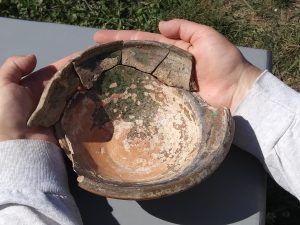

On the other end of the spectrum, strictly utilitarian wares have been found as well. A French Canadian terrine, or dairy pan (left), is the most intact example. Fresh milk was poured into the terrine and left to sit until the cream rose to the top. Although not intended for display, the terrine demonstrates wealth because it indicates the presence of a dairy animal.
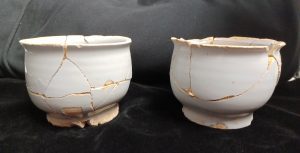

Over the past few seasons, we have pieced together two plain white tin-glazed earthenware ointment pots (right). These most likely held medicinal salves.
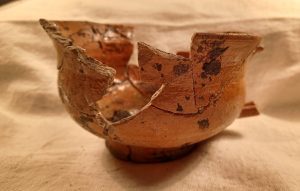

No archaeology project is complete without a mystery or two. We have not yet been able to determine the exact purpose of this flared cup (left). We have only found one piece of a red-edged, white tin-glazed earthenware dish (bottom right). Although this style of ceramic was produced throughout the 18th century, it was most common in the 1730s and ‘40s. Is it a remnant left behind by earlier residents of the house? A family dish brought when moving to Michilimackinac? A cheap old dish bought expressly for a difficult journey to the frontier of the British Empire? We may never know the answer, but it is interesting to ponder these questions.
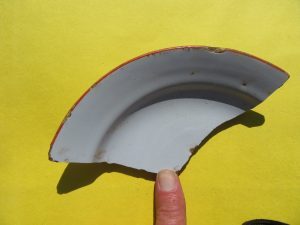

During the 2024 season, programming at Colonial Michilimackinac will highlight the events of 1781 and the relocation to the island. Colonial Michilimackinac opens for the season May 8, 2024. The archaeological excavation will take place daily June 1 – August 17, weather permitting.








